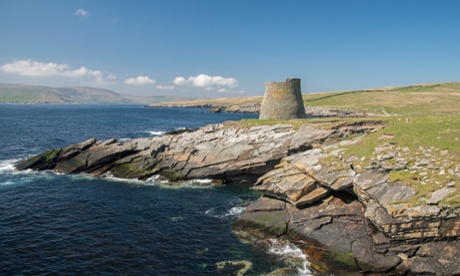
Shetland has always been a place of sanctuary for me. I visited when I dropped out of university and I just loved it from the minute I got there. It’s a bleak but very beautiful place. It’s been 40 years since my first trip, as a lost, miserable, angsty young person, and it’s now become a place where I go to relax and catch up with friends.
The islands each have their own dialect, and locals can pinpoint which one you come from by how you speak. Although I’ve been visiting for four decades, if two people from Whalsay are talking to each other, I still often won’t have a clue what they’re saying.
I was shocked by my first experience of Shetland. I arrived by overnight ferry – it was a 14-hour journey from Aberdeen – and I then got the bus down to Grutness to catch the mail boat to Fair Isle. Even though I was young and wanted an adventure, I was shocked at what I found. There was nothing: it was just the pier. I’m from north Devon and had expected a pretty harbour, and maybe a tea shop.
Shetland’s influences are far more Scandinavian than Celtic. Lerwick is closer to Bergen than Edinburgh. Some visitors expect people to speak Gaelic and that there are going to be cèilidhs. Shetland belonged to Norway until the 15th century and while there is traditional music, it’s not Scottish.
One of my favourite views is of beautiful St Ninian’s Isle. It’s a special place, too – a geographical feature called a tombolo (mound), connected to the Shetland mainland by a spit of sand. Another great view is when you look west from the Shetland mainland, down over Whiteness. There you’ll find böds (Shetland bothies, looked after by the local council), great places to stay in if you’re on a tight budget.
For a crime writer, the islands provide a brilliantly atmospheric backdrop. There is a contrast between the really open landscape, and people from a small community keeping and hiding secrets. The difficult bit about writing is that I assume everyone knows the place as well as I do. Often I talk about the mainland, and then realise people assume I’m talking about the Scottish mainland when, in fact, I’m referring to the Shetland mainland.
The Lounge, in the middle of Lerwick, is the place to go for live music, especially on Wednesdays. You may even stumble across a big-name artist doing a low-key gig. Then there’s the Mareel – a brilliant arts centre, opened in 2012, which is right on the waterfront in Lerwick. It has a cinema, performance space and a recording studio where young Shetlanders can learn to play and produce music.
You must never call it the Shetlands. Islanders are proud, and can be prickly about the name: it’s either Shetland or the Shetland Islands.
The best time to visit is midsummer. The flowers are out, thousands of seabirds are wheeling around the cliffs, and there’s lots of daylight – you can read a newspaper outside at 11pm. Take a ferry at about midnight to the island of Mousa, where there is a broch – an iron-age tower. You can see sea birds coming in to breed. It’s magical. You get the ferry back at about 3am, when it’s already getting light again.
If it’s fish you’re after, try the Scalloway Hotel, in the old capital, Scalloway (six miles west of Lerwick). It decides what fish is going on the menu by what the boats have brought in that day. And if it’s home-baking you want, visit Hay’s Dock restaurant in Lerwick for its sweet and savoury scones and homemade cakes.
The locals never tire of the beauty of the landscape and many of them, when they retire, become accredited guides. It’s lovely that they want to share their knowledge and appreciation with visitors.
The weather often hits hard, so visitors should allow extra time for their journeys. I see people getting tense because they have booked flights and ferries home but if it’s foggy or the seas are rough, then you’ll just have to wait; the small planes won’t fly and the ferries won’t sail.
The Busta House Hotel in Brae is rumoured to have a ghost, though I’ve never seen it and I’ve stayed there many times. It’s an old laird’s house – so it’s a huge property – and is right on the water’s edge.
The best place for puffin watching is Sumburgh Head, at the south end of the Shetland mainland. There used to be a lighthouse there but it’s now a visitor centre and gallery; they run a webcam, so you can check on the puffins in advance.
Sunday afternoon teas are a part of Shetland that I love. Community groups take it in turns to host a tea on Sunday afternoons. It’s a fundraising event, so you pay a few pounds to go in – and you get as much tea and as many home-baked cakes as you can eat. The money goes to the local lifeboat or the community group that’s hosting it, and it’s a great way of meeting local people. Look at the Shetland Times (in print and online) to find out when the teas are on.
Ann Cleeves (anncleeves.com) is 2015 Festival Programming Chair at the Theakstons Old Peculier Crime Writing Festival, 16-19 July, in Harrogate. Her Shetland-set novels are available from Guardian bookshop

